
Subsistence

![]()
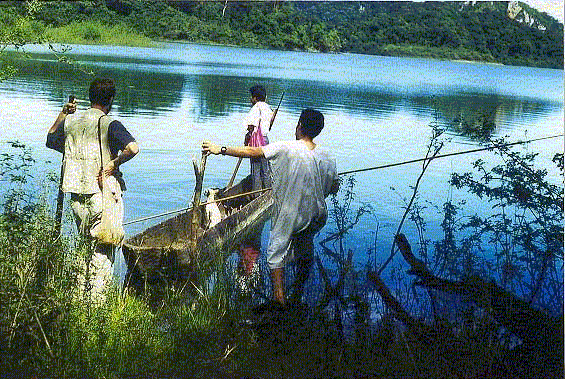
De Ayer...
Food
The Lacandon traditionally acquire food by fishing, hunting, and growing crops (Duby 276). The Lacandon determine when to begin planting by following the seasons, and by watching the stars and for changes in plants and animals (Duby 280).
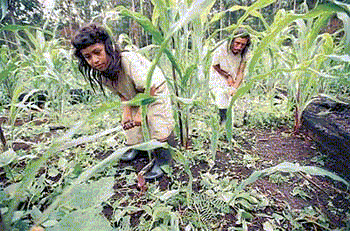
The Lacandon practice swidden agriculture. They begin to clear a piece of forest in January or earlier. After the rainy season in May, they slash and burn a plot of land, or milpa, clearing it of other plants- and plant corn between burned logs. Lacandon farmers weed their milpa twice, and then harvest it between August and October (Duby 280).
The Lacandon mostly grow corn in their milpas, but they also raise beans, squash, and baby tomatoes. They also grow chayotes, chiles, coffee, cotton, garlic, macal, onions, pineapple, sugarcane, sweet potatoes, and watermelons in smaller fields (Duby 280-281).

The Lacandon also gather wild fruits from the forest, such achiotes, aguacates, bananas, lemons, mangoes, and papayas (Duby 280-281).
The
Lacandon also hunt and fish for food. They use the meat of currasow, wild
turkey, partridge, monkeys, wild pigs, armadillos, and many other animals.
They catch fish with spears and fishhooks (Duby 281). The Lacandon
will share what they catch when they fish or hunt with other families or
other caribales (Duby 282).
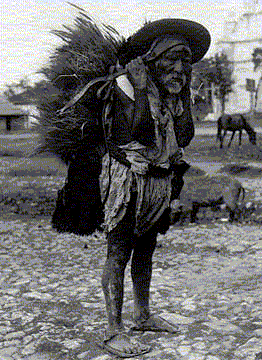
Women keep chickens in the milpa, and prepare them or their eggs (Duby 287).
There are no regular eating hours or mealtimes except for dinner, which occurs whenever the day's work is done. A meal may be spontaneously prepared in order to celebrate the brining in of freshly killed fish or game, even if it's late at night (Duby 281). They eat their food sitting on the floor (Duby 285).
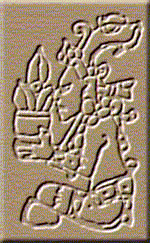
Food is prepared in a small shack near the house. In this shack a table, a metate, and often a corn mill are kept in order to grind corn. Corn is the most important staple of the Lacandon diet. When in season, it may be eaten on the cob. Other times, dried corn is ground into tortillas, tamales, and posol. Posol is drunk with cacao, chile, or salt and sugar or honey. Tamales are filled with meat or beans. The bark of the balche tree is added to fermented sugar in order to produce the balche drink (Duby 281).
A shack for storing corn is either near the living quarters or the milpa. Other foods are stored in baskets or large squash bowls that are hung from the roof of the houses (Duby 285).
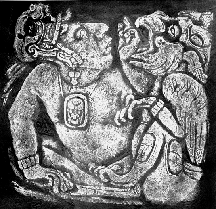
The
Lacandones also gained ladino food and drugs such as mangos, coffee, tea,
cigarettes, lollipops, bread, rice, sugar, fats, and cheap liquor. Cheap
liquor began to replace balche, and several cases of alcoholism
developed (Duby 277-279, Rittlinger 91). Many of the northern
Lacandon plant large fields of tobacco for trade and personal use- men,
women, and children all smoke large cigars (Duby
281).
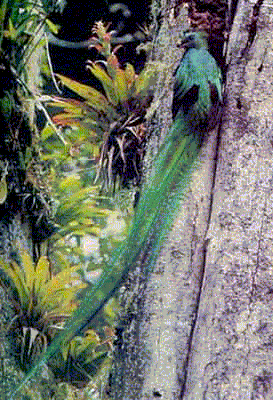
Economics
There are no significant differences in class or wealth among the Lacandon and private property is strictly respected (Duby 287). Only Lacandon of the northern group trade with outsiders. Buyers come for their tobacco, bows, and arrows. They also sell fruit, eggs, and corn to their neighbors and to travelers. The Lacandon buy cloth, salt, sugar, ammunition, and large quantities of white sugarcane liquor from nearby ranchers or from travelers. Lacandon never leave their caribal to go work for an outsider. They would rarely go to even the nearest village, Ocosingo. The little money the northern group acquires is used to buy hunting gear or a radio (Duby 288).
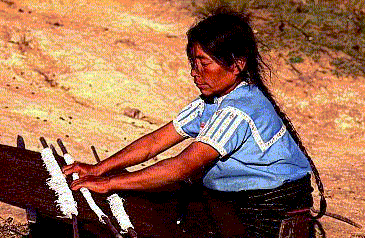
The
Lacandon have a gender division of labor. Men carve crafts, prepare the
fields, and hunt and fish. Sometimes when men hunt or fish, it becomes a
family outing, where the women come too to gather wild fruit or collect
honey while they help. Women also sew, gather ears of corn or sweet
potatoes, prepare corn, cook, fetch water, skin animals brought home,
spin, weave, mend cloth, tend chickens, take care of children and pets,
prepare bark cloth, and make the string from ixtle (Duby
286-287).
![]()
De Ahora...
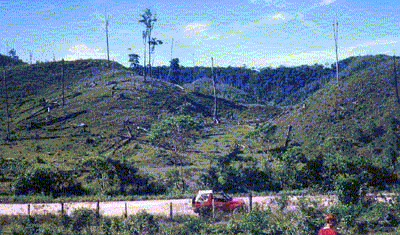
The Lacandon still live in much the same way, though some today may go into tourism such as becoming "professional savages," making arts and crafts for tourists, go into small business in the case of the coffee growers, get some other job in the service sector. Deforestation of the Lacandon Rainforest has been hard on the Maya, because it left many areas beyond repair for both the forest or the Maya to reclaim to use as milpa. The destruction of the forest also means there is less game for the Maya to hunt. (Hach Winik).
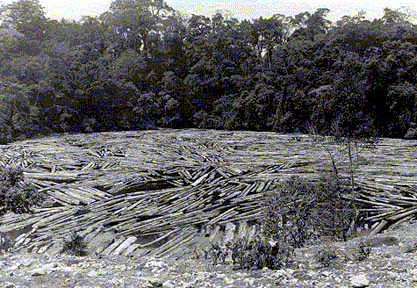
Economics

Today all the Lacandon know how to handle money (Duby 276). The Lacandon of Lacanjá live near the largest intact area of rainforest so game is still plentiful. The Lacandones are the only people allowed to hunt in the reserve. They know the seasonal habits of the jungle animals and have considerable knowledge of herbalism (Hach Winik). More recently, a new highway was built withing 10 kms of Lacanjá. The highway and construction underway to open up the nearby town of "Bonampak as a major tourism will certainly have a great impact upon the community (Hach Winik).
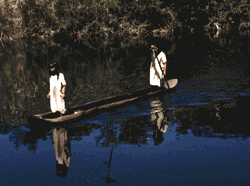
The lake at Metzabók provides good fishing, but" its remoteness limits access to economic opportunities." Nearby the village, some families choose to live traditionally- in isolation surrounded by their milpa and the remaining rainforest. Recent food shortages due to cuts in subsidies as Mexico aligns itself with NAFTA may make a return to traditional agriculture seem an attractive alternative (Hach Winik). Meanwhile, in Najá, the encroaching deforestation is making traditional hunting and agriculture impracticable (Hach Winik).
War and Relief Efforts
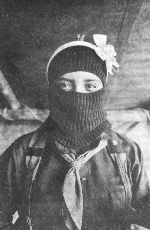
After the signing of NAFTA, the EZLN declared war on the Mexican government, and Chiapas has remained a warzone ever since. While the government's forces continues to swell, "jungle-based forces of the rebel army, while difficult to evaluate in quantitative terms, are significantly smaller, poorly armed and equipped, and undergoing a severe period of protracted existence in harsh, underground conditions.... the Mexican government set fires throughout Chiapas, strategically located in an attempt to force the EZLN out of hiding, and blamed them on the slash-and-burn procedures of peasants. The resulting defoliation led more recently to incredible flooding, from which 2000 are expected to be dead; entire villages have been ruined, and life has come to a standstill in many areas from which villagers have fled to the highlands." The EZLN gives half its funds to peasant communities (such as some Lacandon communities) ravaged by the war, regardless of their ideological alliance (Dominik).
![]()